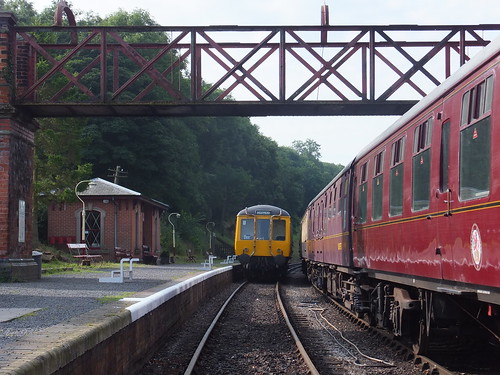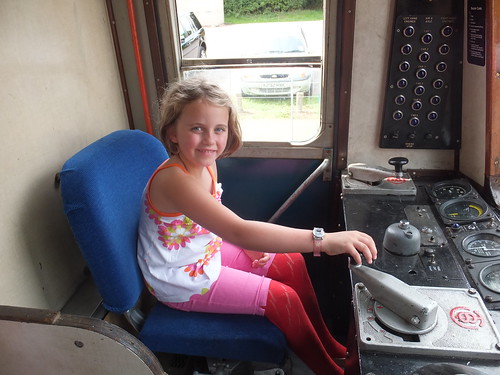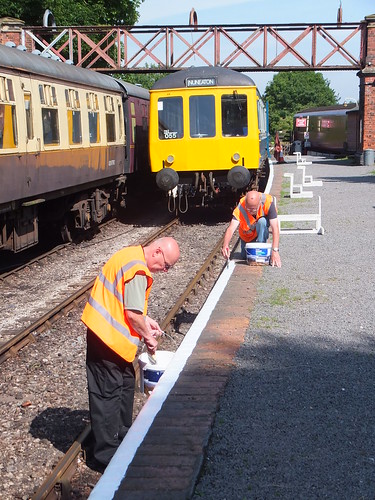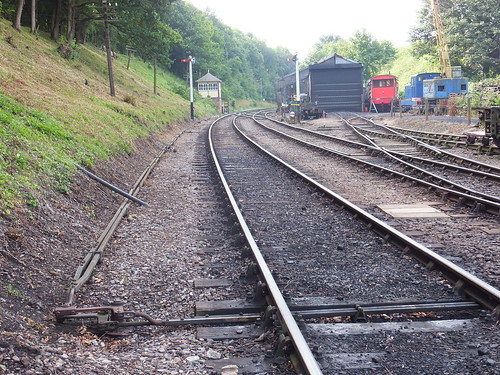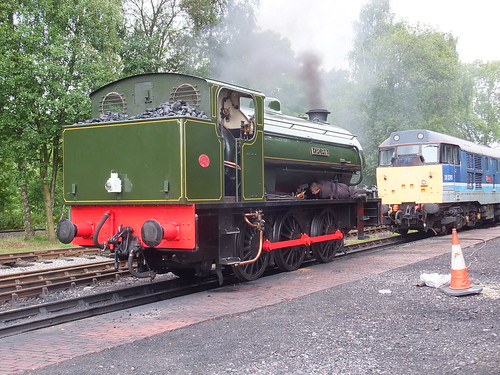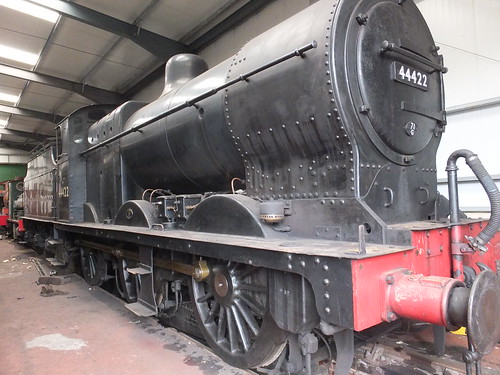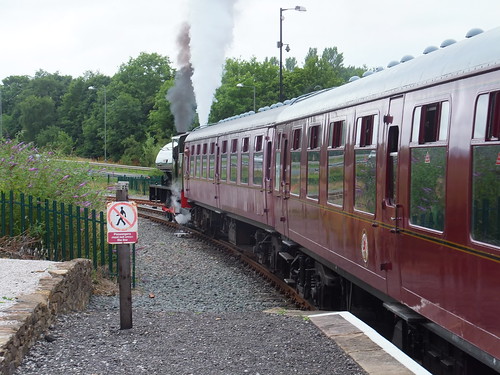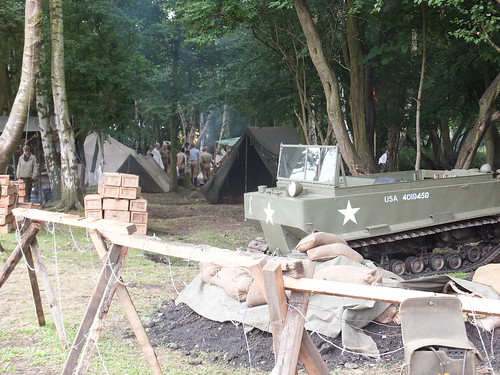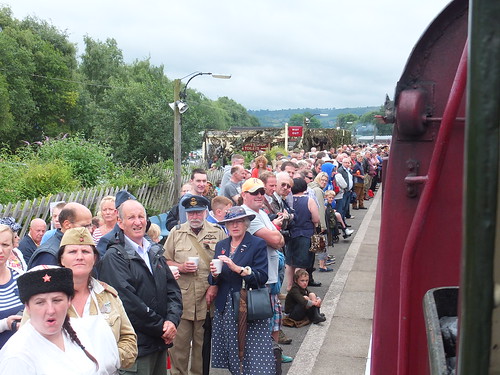In the post Edge Hill, Liverpool I described the growth of the railways around Edge Hill which reached their zenith in the first half of the 20th century. But, like almost all of our railway system, the railways around Edge Hill have changed significantly in the last fifty years, generally becoming simplified.
For comparison with my sketch in the earlier post Edge Hill, Liverpool, here's an incomplete, simplified, not-to-scale sketch of the lines around Edge Hill in 2013. An explanation of the letter references on the sketch is given in the table below the sketch.
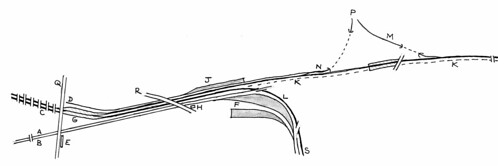 Click for larger image..
Click for larger image..Simplified sketch of Edge Hill area in 2013.
| Ref | Description |
| A | Wapping Up and Down Goods: The cutting which served the Wapping Lines and the Crown Street Lines remains, with two sidings still extending towards the tunnel mouth. The tunnel is out of use although plans have been floated for this tunnel and the Waterloo Tunnel to be re-opened as part of a Metro system. |
| B | Crown Street Up and Down Goods: Although the cutting towards Crown Street remains, Crown Street is now a public park. |
| C | Lime Street Down Fast, Up Fast, Down Slow, Up Slow. |
| D | Waterloo Up and Down Goods: Sidings still extend towards the tunnel mouth but stop short. The tunnel is out of use although plans have been floated for this tunnel and the Wapping Tunnel to be re-opened as part of a Metro system. |
| E | Spekeland Road Coal Wharf: The yard still exists in a derelict form, as does a row of coal offices on Tunnel Road. |
| F | Down Sidings: Still in active use for stabling passenger trains, together with the adjacent Alstom Traincare Depot. |
| G | Edge Hill Station. |
| H | Edge Hill Power Signal Box. |
| J | Tuebrook Sidings. |
| K | Up and Down Chat Moss Lines (to Manchester). |
| L | Up and Down Main Lines (to Crewe). |
| M | Olive Mount Chord. |
| N | Up and Down Bootle Lines. |
| P | Edge Lane Junction (to Bootle, serving docks). |
| Q | Tunnel Road. |
| R | Picton Road Overbridge. |
| S | To Ditton, Runcorn and Crewe. |
| - | Wavertree Technology Park Station (on Up and Down Chat Moss Lines near Olive Mount Chord). |
My visits to Liverpool
On my various visits to Liverpool, I've tried to keep my eyes open regarding the railways. I had a fairly good mooch around Liverpool Lime Street station on Saturday, 18th May 2013 when I attended the Old Locomotive Committee Annual General Meeting.
I decided to visit Liverpool again on Saturday, 22nd June 2013 to have a closer look around the Edge Hill area. I took one of the reasonably-convenient London Midland services from Wolverhampton to Liverpool Lime Street. I've described an earlier trip to Liverpool with London Midland in the post Liverpool by Train.
Liverpool Lime Street Station
My visit to Liverpool on Saturday, 18th May 2013 gave rise to the post Liverpool Lime Street Station.
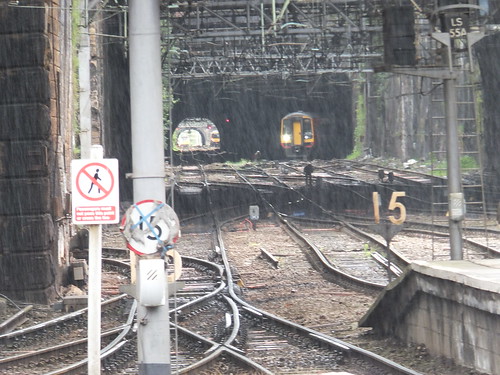 Lime Street Station. View from Platform 2 looking towards Edge Hill.
Lime Street Station. View from Platform 2 looking towards Edge Hill.
On arrival at Lime Street station on 22nd June 2013, I took a local service for the short trip to Edge Hill station. Platforms 1 to 6 at Lime Street are used by the various local services and the first departure calling at Edge Hill was one of the execrable 'Pacers'.

Liverpool Lime Street station, showing the 'Pacer' in Platform 2 which I took to Edge Hill.
Edge Hill Station
The station retains its four through platforms but the two bay platforms at the Manchester end have long gone. The platform canopies have been removed, revealing the pleasing design of the two 1836 station buildings, one on the north island platform, one on the south. Each island platform remains connected to Tunnel Road by a cobbled ramp but only the ramp to the north island platform is still in use (access to the south island platform is via a subway from the north island platform). After spending some time studying the historic station at Edge Hill, I left the station and made my way along Tunnel Road, past the derelict coal offices which served Spekeland Road Coal Wharf.
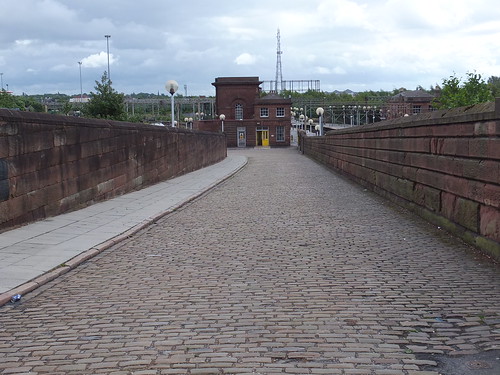 A modern view of the road access to Edge Hill station, viewed from Tunnel Road.
A modern view of the road access to Edge Hill station, viewed from Tunnel Road.
Crown Street
I left Tunnel Road and continued along the various streets running close to the original railway route to Crown Street. Although sidings still extend towards Crown Street, the railway is not very accessible. The sidings stop just short of Crown Street but trees, undergrowth and fencing now make the lines invisible. I could just see an electrification mast but all the Overhead Line Equipment had long gone. The area where Crown Street railway yard stood is now a park and playground. The park includes a brick ventilation shaft, presumably on the disused Wapping Tunnel.
 Crown Street in 2013, with tunnel ventilation shaft in the right background and the Anglican Cathedral on the left in the distance.
Crown Street in 2013, with tunnel ventilation shaft in the right background and the Anglican Cathedral on the left in the distance.
Wavertree Botanic Gardens
From Crown Street, I walked back to Edge Hill, crossing over one of the many bridges spanning the approach to Lime Street Station and continued to Wavertree Botanic Gardens. I believe this was the location of the famous 1930 Pageant and Exhibition celebrating the 100th birthday of the Liverpool and Manchester Railway. At this exhibition, as well as various static locomotive exhibits, the restored 1830 locomotive 'Lion' gave rides to the public. I've written a number of posts about 'Lion' and her present-day supporters' club 'The Old Locomotive Committee' - you can find all my posts here or go to the Old Locomotive Committee website here.
 Wavertree Botanic Gardens in 2013.
Wavertree Botanic Gardens in 2013.
Picton Road Bridges
Leaving the botanic gardens, I carried on walking, crossing the railway on the long Picton Road overbridge and passing just behind Edge Hill Power Signal Box.
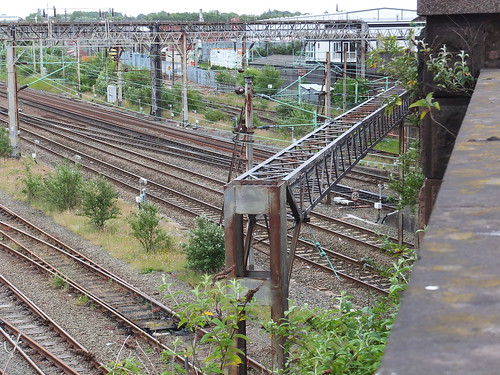 View looking towards Manchester from Picton Road overbridge. L-R: Former Up and Down goods lines to Waterloo Tunnel Mouth, Up and Down Chat Moss, Up and Down Main, Former Wapping goods lines. The present Power Signal Box is just visible in the background.
View looking towards Manchester from Picton Road overbridge. L-R: Former Up and Down goods lines to Waterloo Tunnel Mouth, Up and Down Chat Moss, Up and Down Main, Former Wapping goods lines. The present Power Signal Box is just visible in the background.
Further along Picton Road, I passed the Alstom Traincare Depot and continued under a group of bridges carrying the lines to Crewe and associated sidings. I then turned off to make my way north along Rathbone Road to the bridge over the Liverpool and Manchester railway. Freight by rail is now restricted to container traffic, block loads and engineering trains so the whole of the Edge Hill Grid Iron has gone. As part of a Regeneration Programme, much of the area has been regenerated as 'Wavertree Technology Park' and two million pounds was invested in a new station on the Liverpool and Manchester route which opened in 2000, rejoicing in the name 'Wavertree Technology Park'. This is adjacent to the Rathbone Road bridge. From the road bridge looking east, Olive Mount Cutting was visible. This was one of the major engineering achievements during the construction of the Liverpool and Manchester Railway. Originally double track, it was widened around 1870 to accommodate four tracks but the route has now been simplified to double-track.
Access to the Bootle Branch had originally been from Liverpool direction but in 1883 the double-track Olive Mount Chord was opened, forming a triangle so that trains from Manchester direction could directly reach the Bootle Branch and the docks which it served. Following a fire at Edge Lane Junction signal box in 1988, the Olive Mount Chord was abandoned. However, twenty years later the Chord was re-instated (as a single line) to improve the facilities for rail freight.
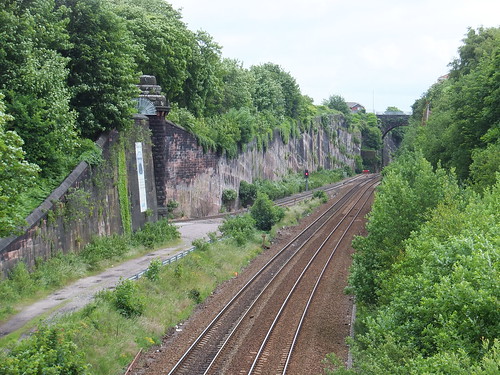 Looking towards Olive Mount Cutting and Manchester from Rathbone Road bridge. The new Olive Mount Chord diverges on the left.
Looking towards Olive Mount Cutting and Manchester from Rathbone Road bridge. The new Olive Mount Chord diverges on the left.
After a short wait at Wavertree Technology Park station, another 'Pacer' arrived which took me back to Lime Street Station. By this time fairly tired, I caught the first available service back to Crewe and Wolverhampton.

Wavertree Technology Park station, looking towards Edge Hill.
The railway photographs I took during this visit have been added to the set Liverpool Area Railways.
Signalling
My earlier post Liverpool Lime Street Station briefly described the power box at Lime Street which is still in use. In the Edge Hill area, all the earlier manual signal boxes have been replaced by Liverpool Edge Hill Power Signal Box. This Power Box was built during electrification in the 1960s with an 'NX' signalling panel which I understand has been replaced. Oddly enough, Edge Hill Power Signal Box is discussed in Pevsner's 'The Buildings of England' book reference [2].
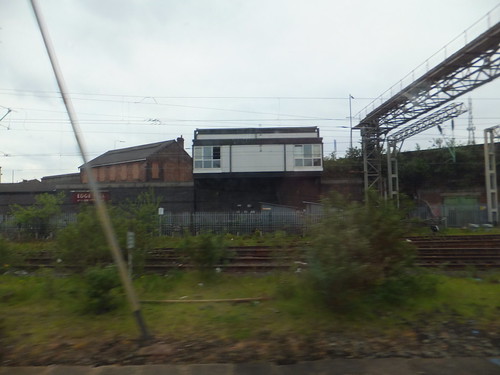 The Power Signal Box at Edge Hill.
The Power Signal Box at Edge Hill.
External links
Liverpool and Manchester Railway (Wikipedia).
London and North Western Railway (Wikipedia).
London, Midland and Scottish Railway (Wikipedia).
Pictures of Exhibition Junction by edgehillsignalman.
Edge Hill Archive
Book References
[1] 'An Illustrated History of Liverpool's Railways' by Paul Anderson, published Irwell Press (ISBN 1-871608-68-6).
[2] 'The Buildings of England - Lancashire: Liverpool and the South-West' by Richard Pollard and Nikolaus Pevsner, published by Yale University Press (ISBN 0 300 10910 5). This book may be previewed here.
Track Diagrams
For more details of the present track layout, refer to the latest edition of 'Railway Track Diagrams Book 4: Midlands & North West', published by Trackmaps (ISBN: 0-9549866-0-1).
Related articles in this Blog
Liverpool Lime Street Station.
'Black 5' to Birmingham.
Edge Hill, Liverpool.
My Pictures
Liverpool: The City.
Liverpool Area Railways.




